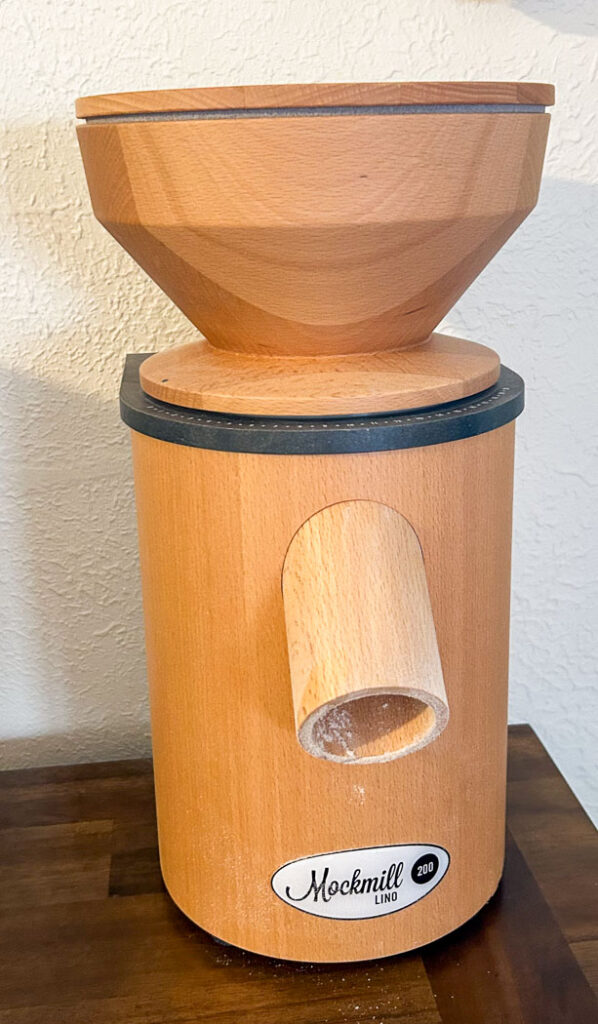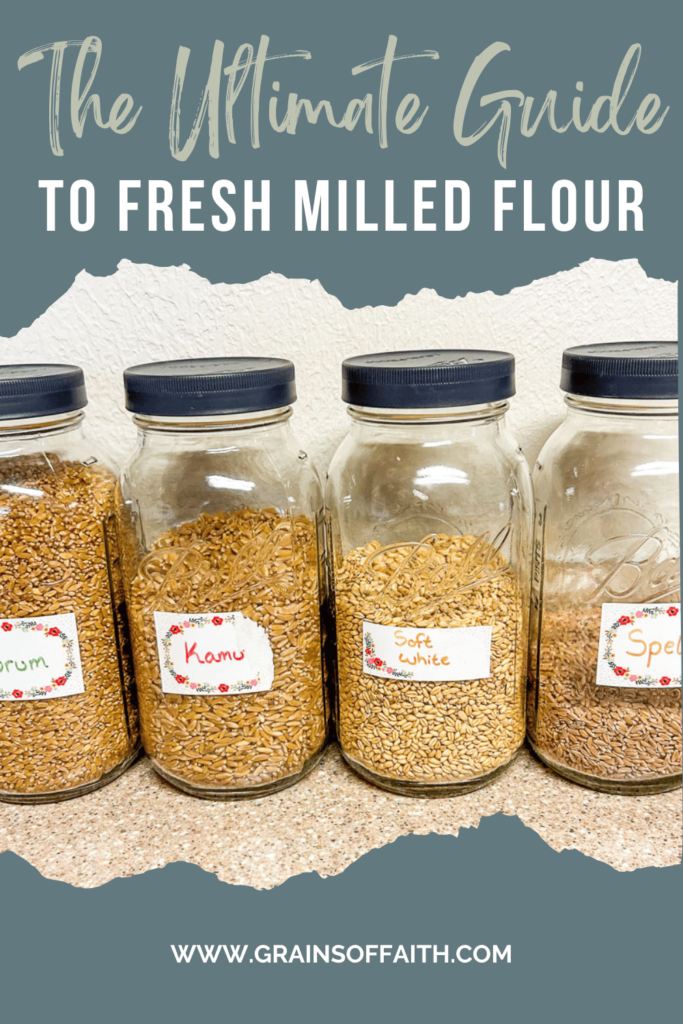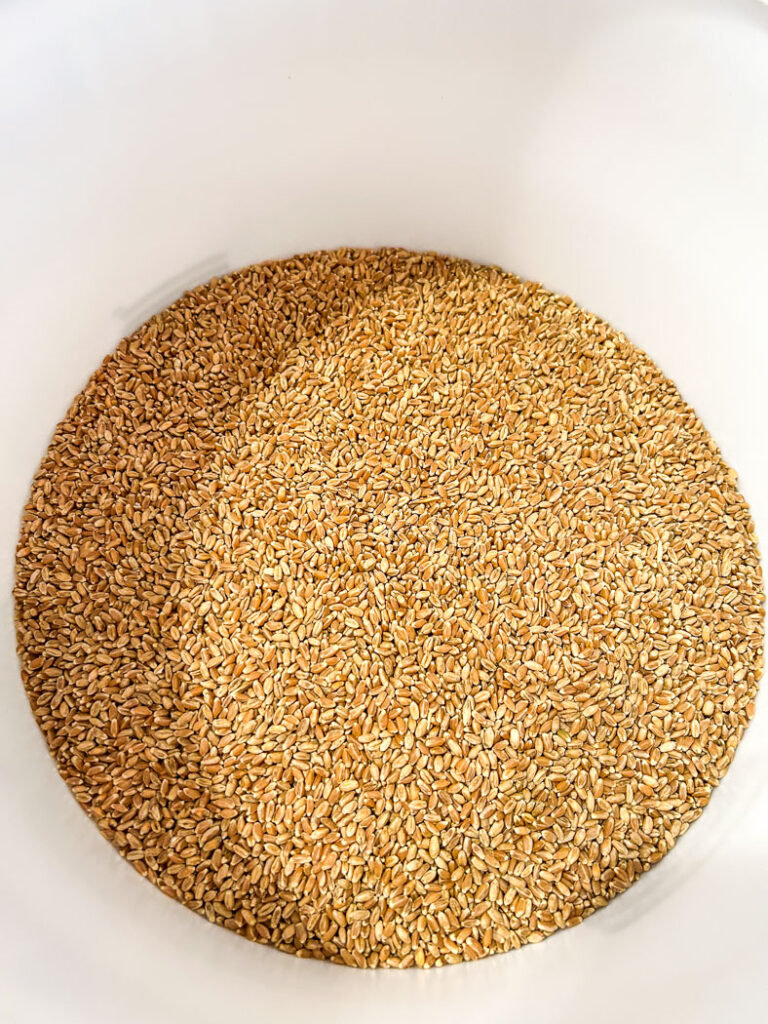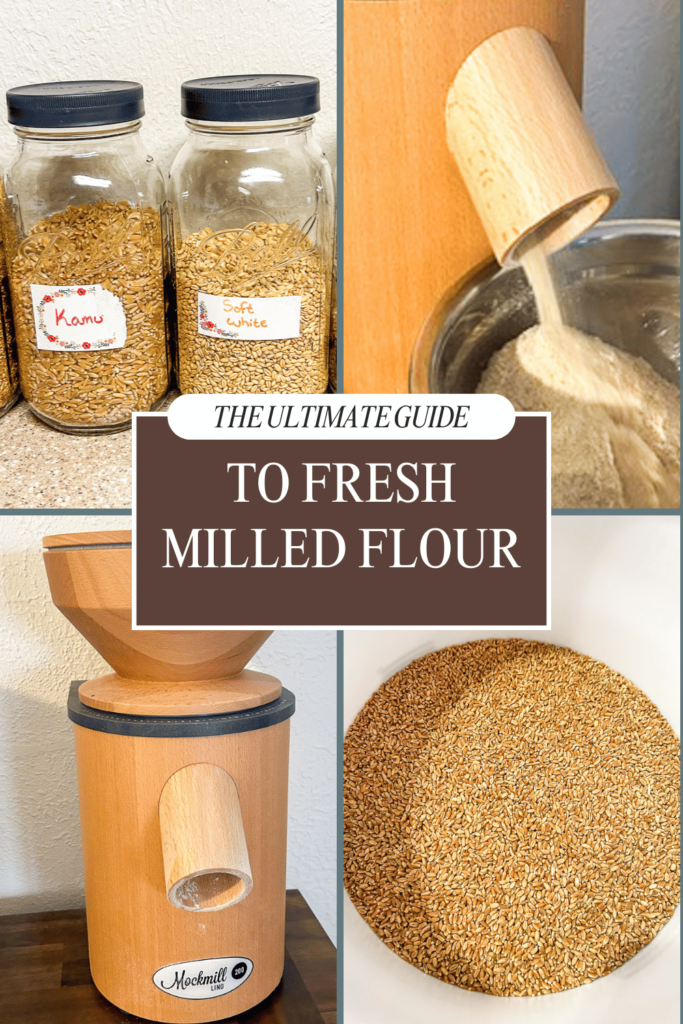Fresh milled flour can truly transform your baking experience, especially if you want to boost the flavor, nutrition, and overall quality of your baked goods. Unlike the flour you find at the store, freshly milled flour retains its full nutritional benefits. Whether you’re an expert baker or just getting started, this comprehensive guide will cover everything you need to know about milling your own flour, from selecting the right grains to exploring the benefits and more. Get ready to take your baking to the next level with the freshest, most wholesome flour possible!
As an Amazon affiliate, I earn from qualifying purchases. This means that when you click on a link on this site and make a purchase, I may earn a small commission, which helps support the work of this blog. Rest assured, I only recommend products that I genuinely love and trust.

I bought my own grain mill and started milling my own flour after I learned how store-bought flour is ‘dead’ and ripped from all nutritional value. This has completely changed the way I look at food and made me want to cook at home from scratch.
If you’re thinking about diving into the fascinating world of home milling, I get how the first steps can feel a bit intimidating. With so many mills on the market and a wide range of grains to try out, it’s easy to get overwhelmed by all the information and choices. You might have some questions about turning whole grains into fresh flour right in your kitchen: Which mill is the best fit for you? How does the milling process work? Where do I get my grains? And how will freshly milled flour affect your baked goods? This blog post is here to simplify the home milling experience, offering tips and insights to help you navigate this exciting new venture of making your own flour. So, let’s jump in and explore the ins and outs of home milling together!
Benefits of Fresh Milled Flour:
Maximum Nutrition
So you might be thinking, “Why would I mill my own flour at home when I can just go to the grocery store and buy it?” I have heard this a few times now, and the answer is because you are processing the whole kernel of grain, also called berries, into flour. This retains all of the grain’s nutrients, including essential vitamins, minerals, and fiber. The structure of a grain kernel includes three key sections: the endosperm, primarily composed of starch; the bran, which serves as the outer protective layer; and the germ, the inner core that has the ability to sprout into a new plant. Since fresh milled flour includes the bran, germ, and endosperm, it is packed with these essential nutrients:
- B Vitamins (B1, B2, B3, B6, Folate) – Support energy production, brain function, and red blood cell formation.
- Vitamin E – A powerful antioxidant that promotes skin health and supports the immune system.
- Iron – Essential for oxygen transport in the blood, helping to prevent anemia.
- Magnesium – Supports muscle and nerve function, as well as bone health.
- Zinc – Plays a vital role in immune function and wound healing.
- Phosphorus – Helps with bone strength and cellular repair.
- Potassium – Important for heart health and proper muscle contractions.
Refined white flour, or commercial store-bought flour, undergoes a process that strips away the bran and germ. This process removes the fiber, vitamins, and minerals from the flour. Then, it is “enriched” by adding synthetic vitamins back into the flour. However, this does not fully replace the lost nutrients. Flour enrichment laws stem from a time when nutrient deficiencies were widespread, particularly after World War II. The government mandated that refined flours be enriched with synthetic vitamins and minerals to combat conditions like pellagra (from niacin deficiency) and beriberi (from thiamine deficiency). However, the irony is that these deficiencies were largely caused by the industrial removal of the bran and germ from grains in the first place!
No Additives or Preservatives
Commercial flours often contain bleaching agents, stabilizers, and preservatives to extend shelf life. When you mill your own, you control exactly what goes into your food—nothing but pure, whole-grain goodness.
Better digestion
Thanks to fresh milled flour’s higher fiber content, it supports gut health and regularity. Since it retains natural enzymes, it is more gentle on the digestive system.
Balanced blood sugar
This is a huge factor for my family since my youngest daughter is a type 1 diabetic, and yet another reason why I love milling my own flour! Here’s how it supports better blood sugar control:
Lower Glycemic Impact:
Because fresh milled flour retains the bran and germ, it has a lower glycemic index than refined flour. The fiber slows down the digestion and absorption of carbohydrates, preventing sharp blood sugar spikes.
High Fiber Content:
The fiber in fresh milled whole grains (such as wheat, spelt, or einkorn) helps regulate blood sugar by:
- Slowing glucose absorption into the bloodstream
- Improving insulin sensitivity
- Supporting gut health, which plays a role in metabolic balance
More Balanced Macronutrients:
Fresh milled flour contains more protein and healthy fats than processed white flour, helping to further stabilize blood sugar levels. These nutrients slow digestion and reduce the rapid breakdown of carbohydrates into sugar.
Tips for Using Fresh Milled Flour to Support Blood Sugar Health
- Choose ancient grains like einkorn or spelt, which have a naturally lower GI.
- Opt for sourdough fermentation, which pre-digests some of the carbohydrates and lowers the GI even more.
- Pair fresh milled flour with fiber-rich ingredients, proteins, and healthy fats to further stabilize blood sugar.
By making the switch to fresh milled flour, you can enjoy more nutritious, blood sugar-friendly baked goods without sacrificing taste or quality!
Choosing a Grain Mill:
Choosing the right type of grain mill depends on your needs, budget, and baking goals. Here are the key factors to consider when selecting the best mill for fresh milled flour:

Manual vs. Electric Grain Mill
- Manual Mill– Require hand cranking and are great for off-grid use or small batches. They are typically more affordable but require more effort.
- Electric Mill– Powered by electricity, making milling quick and effortless. Ideal for frequent bakers or those who need large quantities of flour.
Milling Mechanism
- Stone Mills– Use natural or synthetic stones to grind grain slowly, preserving nutrients and creating a fine, consistent flour. Best for baking.
- Impact Mills– Use stainless steel blades to pulverize grains at high speed. Great for fine flour but may heat the flour slightly.
- Burr Mills– Use steel or ceramic burrs to crush grains; they offer adjustable coarseness settings and are durable.
Grain Compatibility
Make sure the mill can handle the types of grains you want to use. Some mills can process only soft grains (like wheat and spelt), while others can handle hard grains, legumes, and even nuts.
Flour Texture & Adjustability
If you need a variety of textures, such as fine flour to coarse meal, choose a mill with adjustable settings. Stone and burr mills generally offer more control over texture compared to impact mills.
Size & Storage
When choosing a mill, consider kitchen space. Some mills are compact, while others take up more counter or storage space. If portability is important, a smaller manual mill might be a good option.
Speed & Efficiency
Electric mills can grind large batches in minutes, while manual mills require more time and effort. High-speed electric mills are best for large families or frequent baking.
Budget & Durability
Manual grain mills range from $50–$300, while electric mills typically cost $200–$800. Investing in a high-quality mill ensures longevity and better milling performance.
Popular Grain Mill Options
- Mockmill 100/200– Stone mill, great for home bakers, adjustable settings.
- NutriMill Classic– High-speed impact mill for fine flour.
- Country Living Grain Mill– Sturdy manual burr mill, ideal for off-grid use.
- Wonder Mill Electric– Fast and efficient impact mill, good for large batches.
Final Thoughts on Choosing the Right Grain Mill
Your ideal grain mill depends on how often you bake, what grains you want to mill, and whether you prefer convenience or a hands-on experience. If you want ultimate control over freshness and nutrition, investing in a quality mill is well worth it!
How To Store Fresh Milled Flour?
Properly storing home-milled flour is essential to maintaining its freshness, flavor, and nutritional benefits. Unlike store-bought flour, which is stripped of the germ and bran, fresh-milled flour contains natural oils that can go rancid if not stored correctly. Here’s how to keep your flour fresh and nutrient-rich for as long as possible:
Use It Fresh (Best Option!)
For optimal nutrition and flavor, use your fresh-milled flour right away or no longer than within 24 hours. Milling flour in small batches as needed ensures peak freshness.
Short-Term Storage (Up to 7 Days)
Store flour in an airtight container to protect it from moisture and pests. Keep it in a cool, dark place, such as a pantry or cupboard, away from direct sunlight and heat sources.
Refrigeration (Up to 2 Months)
If you plan to use the flour within a few weeks but not immediately, store it in the refrigerator. I typically do this if I am baking and accidentally mill too much flour. Use an airtight glass jar, food-grade plastic container, or resealable bag to prevent absorption of odors and moisture.
Freezing (Up to 6-12 Months)
For long-term storage, freezing is the best option. Cold temperatures preserve freshness and prevent rancidity. Store flour in an airtight container or vacuum-sealed bag to prevent freezer burn. To use frozen flour, let it come to room temperature before baking to ensure proper texture and hydration.
Grinding Only What You Need
Since fresh flour loses its nutritional value over time, it’s best to mill only what you need for the next few days. Whole grains have a much longer shelf life and can be stored for years in a cool, dry place.
By following these storage methods, you’ll keep your fresh-milled flour tasting great and packed with nutrients for all your baking needs!

How To Store Wheat Berries?
Properly storing wheat berries ensures they stay fresh, nutritious, and free from pests. Since whole wheat berries have a long shelf life, they can be stored for years if kept in the right conditions. Here’s how to store them for short- and long-term use:
Choose the Right Storage Container
- Use airtight containers to keep out moisture, pests, and contaminants. Good options include:
- Food-grade gallon buckets with gamma lids
- Glass jars with tight-fitting lids
- Mylar bags with oxygen absorbers
- Vacuum-sealed bags
- Heavy-duty plastic or metal containers
Store in a Cool, Dry Place
- Keep wheat berries in a cool, dark area like a pantry, basement, or cupboard.
- Ideal storage temperature: 50°F – 60°F (10°C – 15°C) for long shelf life.
- Avoid exposure to heat, humidity, and direct sunlight, as these can cause spoilage.
Use Oxygen Absorbers for Long-Term Storage
- If storing for years, place oxygen absorbers (300-500cc per gallon of grain) in Mylar bags or buckets to prevent oxidation and insect infestation.
- Vacuum sealing also helps extend shelf life.
Keep Away from Pests
- Store wheat berries in rodent-proof containers (metal or thick plastic).
- Add bay leaves to storage containers as a natural pest deterrent.
- Freeze wheat berries for 72 hours before long-term storage to kill any potential insect eggs.
Refrigeration & Freezing (Optional for Extra Freshness)
- Refrigerator: Can store wheat berries for up to a year in an airtight container.
- Freezer: Can store indefinitely when kept dry and well-sealed. This also helps prevent bug infestations.
Shelf Life of Wheat Berries
- Room Temperature (Cool, Dry Storage): 10-30 years if stored properly.
- Refrigerated: 1-2 years.
- Frozen: Indefinite.
By storing wheat berries correctly, you ensure that you always have fresh, nutrient-rich grains ready to mill into the highest-quality flour whenever you need it!
Types of Grain and it’s Uses:
Different types of grains offer unique flavors, textures, and nutritional benefits, making them perfect for a wide range of cooking applications. Here’s a guide to some of the most popular grains and how to use them:

Wheat (Hard & Soft Varieties)
- Hard Red Wheat– High in protein, great for yeast breads and sourdough.
- Hard White Wheat– Milder flavor, good for sandwich bread, pizza dough, and dinner rolls.
- Soft White Wheat– Lower protein, ideal for pastries, cakes, muffins, and cookies.
Durum Wheat– High-protein wheat used for making pasta and semolina flour.
Einkorn
- Ancient wheat variety with a sweet, nutty flavor and a lower gluten content.
- Easier to digest than modern wheat.
- Best Uses: Bread, pancakes, muffins, cookies, crackers
Spelt
- Ancient grain with a mild, slightly sweet flavor.
- Easier to digest than common wheat and rich in nutrients.
- Best Uses: Bread, pasta, cookies, waffles, crackers
Rye
- Dark, earthy-flavored grain that retains moisture well in baking.
- Contains less gluten, producing denser bread.
- Best Uses: Rye bread, sourdough, crackers, pancakes
Kamut (Khorasan Wheat)
- Ancient grain with a buttery, nutty taste and a high protein content.
- Easier to digest than modern wheat.
- Best Uses: Bread, pasta, cereals, waffles, baked goods
Barley
- Slightly chewy texture with a mild nutty flavor.
- Low gluten content, best mixed with other flours in baking.
- Best Uses: Soups, stews, porridge, barley flour for pancakes and bread
Corn
- Ground into cornmeal or corn flour for a naturally gluten-free option.
- Can be used for sweet or savory dishes.
- Best Uses: Cornbread, tortillas, polenta, grits, and muffins
Millet
- Small, gluten-free grain with a slightly sweet, mild flavor.
- Light and fluffy when cooked.
- Best Uses: Porridge, gluten-free baking, pilafs, flatbreads, and baby cereal
Sorghum
- Gluten-free, high in antioxidants, and has a slightly sweet, earthy flavor.
- Great alternative to wheat in baking.
- Best Uses: Flatbreads, sorghum flour for gluten-free baking, porridge
Buckwheat
- Despite its name, it’s not related to wheat and is naturally gluten-free.
- Strong, nutty flavor and high protein content.
- Best Uses: Pancakes, noodles, porridge, gluten-free baking
Where To Buy Grains:
You can buy wheat berries from a variety of sources, both online and in local stores. Here are some of the best places to purchase high-quality wheat berries:
Online Retailers (Convenient & Bulk Options)
- Country Life Natural Foods– Offers bulk grains such as organic and conventional wheat berries. Great store to buy grains, rice, beans, lentils, and more! They also carry sourdough supplies, fermenting kits, and canning supplies. Along with Bosch mixers, Nutrimill mixers, and Nutrimill classic grain mills. Get 10% off your whole order using the code AMBER at checkout. Shop Now
- Amazon– Grand Teton Ancient Grains, Wheatland, & Palouse Brand.
- Pleasant Hill Grain– Wide selection of wheat varieties, including hard red, hard white, and ancient grains.
Local Health Food Stores
- Many health food stores and natural grocery stores carry wheat berries in their bulk grain section.
- Stores like Whole Foods, Sprouts, and Natural Grocers may have organic or non-GMO options.
Bulk Food Co-Ops & Farmers’ Markets
- Check local co-ops or community-supported agriculture groups.
- Some farmers’ markets have vendors selling locally grown wheat berries.
Local Farms & Local Mill
- Many farms sell wheat berries directly to consumers. Look for grain farms in your area.
- Mills, such as Great River Milling or Janie’s Mill, sell fresh-milled whole wheat flour and whole wheat berries. You can order these online on their websites.
Tips for Buying Wheat Berries
- Choose the right type (Hard Red, Hard White, Soft White, Einkorn, Spelt, etc.) based on your baking needs.
- Look for organic or non-GMO options if you prefer minimal pesticide exposure.
- Buy in bulk to save money and store for long-term use.

Baking with Fresh Milled Flour: Tips & Techniques
Baking with freshly milled flour is a game-changer for flavor, nutrition, and texture. However, because it retains all parts of the grain (bran, germ, and endosperm), it behaves differently than store-bought flour. Here’s how to get the best results when baking with freshly milled flour:
Understanding Fresh Milled Flour
Unlike refined flour, fresh milled flour contains more fiber, natural oils, and nutrients. This affects:
- Absorption: Fresh flour absorbs more liquid, so recipes may need adjustments.
- Gluten Development: The bran and germ can interfere with gluten formation, requiring extra kneading or hydration.
- Texture & Flavor: Expect a richer, more complex taste and a slightly denser texture in baked goods.
Adjusting for Hydration (More Liquid Needed)
Whole grain flours absorb more moisture than white flour. Increase liquid by 5-10% when using fresh-milled flour. Let the flour rest (autolyze) for 20-30 minutes after mixing to allow it to fully absorb moisture before kneading.
Kneading & Gluten Development
Knead dough longer than usual to strengthen the gluten network. Consider using a stretch-and-fold method (for sourdough or artisan breads) instead of aggressive kneading. If making delicate baked goods (like cakes or muffins), don’t overmix to avoid toughness.
Related Posts:
Shop the Post
Visit shop my favorites – Kitchen/cooking page for a wide variety of supplies for milling flour.
- Komo Mill
- Nutrimill Classic
- WonderMill
- Ankarsrum Mixer
- Bosch mixer
- Cooking with Ancient Grains Cookbook
- Hard white wheat
- Hard Red Wheat
- Einkorn
- Spelt
- Kamut
- Soft White wheat
Country Life Natural Foods
Get 10% off your whole order using the code AMBER at checkout.
Great store to buy grains, rice, beans, lentils, and more! They also carry sourdough supplies, fermenting kits, and canning supplies. Along with Bosch mixers, Nutrimill mixers, and Nutrimill classic grain mills. Shop Now
As an affiliate, I earn from qualifying purchases. This means that when you click on a link on this site and make a purchase, I may earn a small commission, which helps support the work of this blog. Rest assured, I only recommend products that I genuinely love and trust.

Ohh will have to get back to this when I can afford a mill! I’ve been wanting one forever
You won’t regret the investment!
Fresh milled flour is the best! Once you try it you’ll never go back! Thanks for this fantastic rundown of all the benefits.
Yes, I agree! Thank you!
Great info, Thanks for sharing!
Thanks so much for the detailed info on fresh milled flour! This is such a great reference to save and come back to!
Your welcome! I’m glad it was helpful.
I just got my mill in and all of your info is going to be so helpful! Thanks for sharing!
Awesome, happy baking! I’m so excited for you!
I was JUST talking about this with my husband. This is my next phase of optimizing our family’s nutrition. Thank you for sharing all this information!
Your welcome! My family loves our fresh milled flour adds so much flavor to everything and I love that it full of nutrition!
I love milling my own flour. This was great information! I have been wanting to upgrade my mill so thank you for the recommendations.
Yes, of course! Good luck with finding a new mill! Just FYI a lot of brands are on backorder right now.
Love this! We just started milling, so I am pinning this post to continue to reference!
Thats great! Happy baking!
Wow, so much information. Thank you
Thank you!